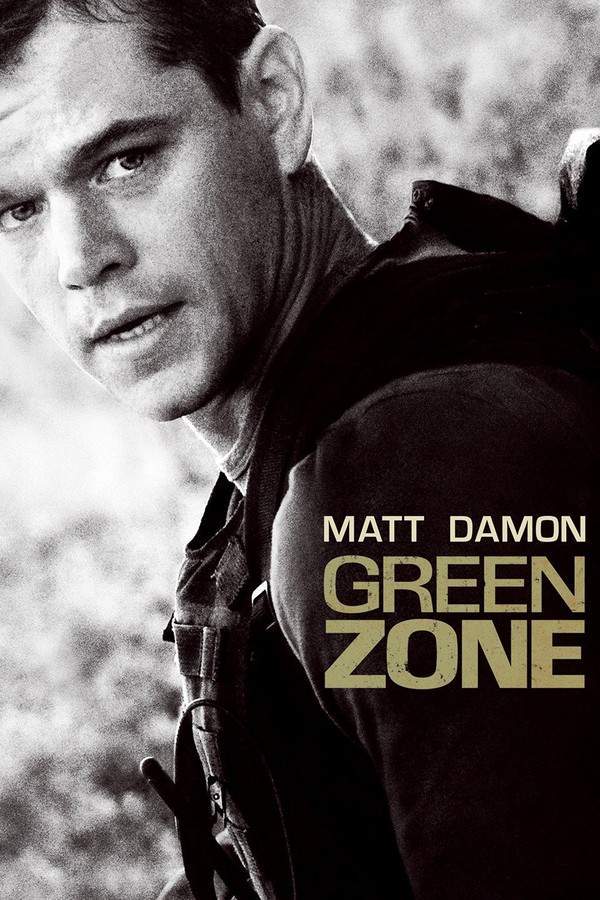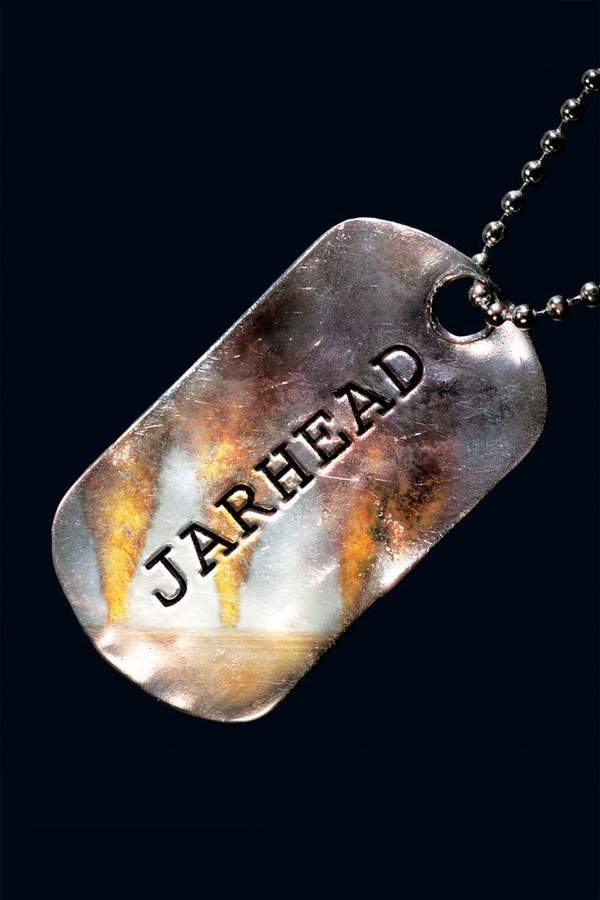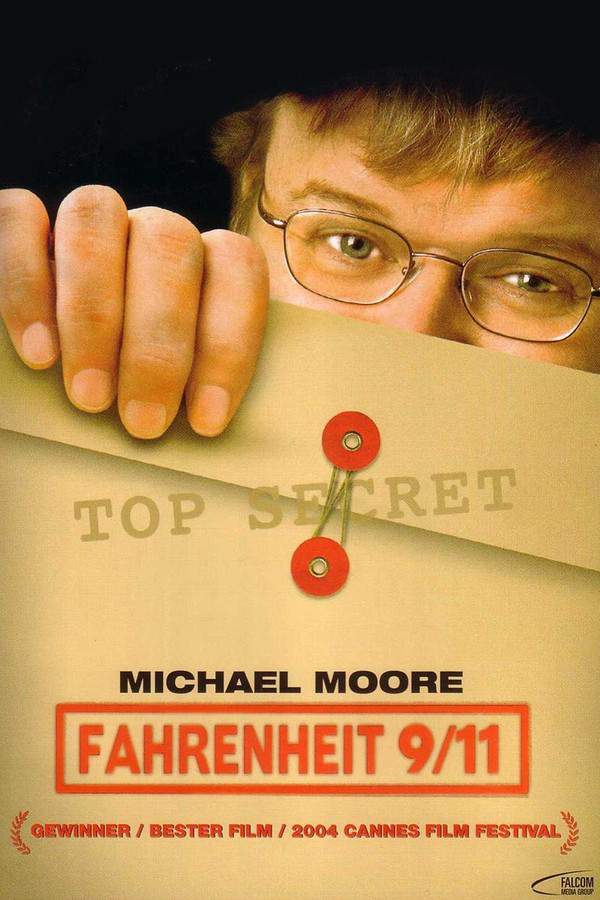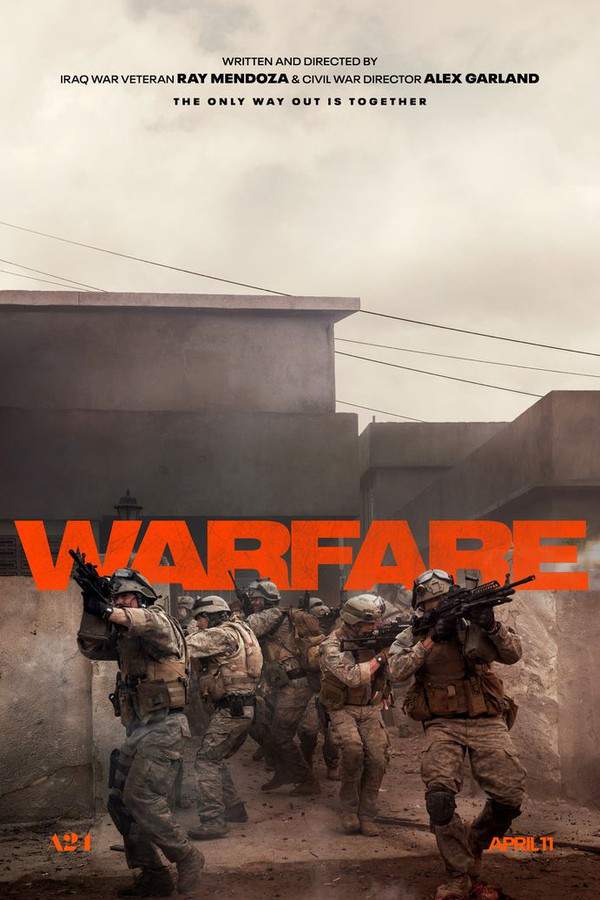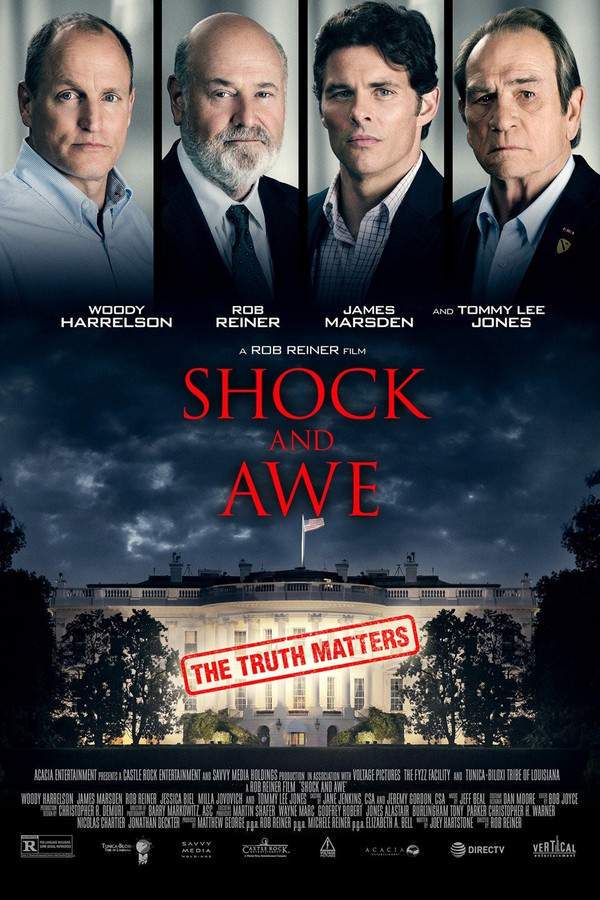
Shock and Awe 2018
Test your knowledge of Shock and Awe with our quiz!
Shock and Awe Plot Summary
Read the complete plot summary and ending explained for Shock and Awe (2018). From turning points to emotional moments, uncover what really happened and why it matters.
In 2006, the Senate Committee on Veteran Affairs convenes to deliberate the future funding of the Veteran Affairs, and at this pivotal moment, we meet retired Army veteran Adam Green, a young man who lost his legs while serving his country. Adam, who enlisted in the military at the tender age of 19 and was deployed to Iraq, bravely shares his harrowing experience of how just hours after arriving in Iraq, his transport vehicle was struck by an IED, causing a life-altering injury that left him wanting answers about the true reasons behind the war in Iraq.
As Adam’s testimony unfolds, another narrative takes shape: a group of dedicated journalists, including Warren Strobel and Jonathan Landay, are on a mission to probe the claims made by the Bush Administration regarding Saddam Hussein’s purported possession of weapons of mass destruction, which served as a justification for the 2003 invasion of Iraq, ominously dubbed “Shock and Awe.” President George Bush asserted that this war was essential to safeguard the world from a looming threat, aiming to dethrone Saddam and spread democracy throughout the Middle East.
In this backdrop, we flash back to September 2001, when the tragic events of 9/11 send shockwaves through the nation. Amidst this turmoil, John Walcott, the bureau head for the Knight Ridder news service—a collective of 31 newspapers—dispatches reporters Warren Strobel and Jonathan Landay to scrutinize the unfolding story. Despite the State Department’s insistence on Iraq’s involvement in the attacks, a burgeoning narrative suggests that Al-Qaeda, led by Osama bin Laden, is the true perpetrator.
Walcott is adamant that the State Department’s approach to instilling democracy in the Middle East is misguided, rooted in nationalism rather than genuine patriotism. This sentiment is echoed by Vlatka Landay, Jonathan’s wife, who expresses her skepticism towards the administration’s justifications. Meanwhile, Lisa Mayr, who resides in the same building as Strobel, begins a romantic relationship with him, providing a personal dimension to the unfolding investigation.
As the investigation deepens, it is revealed that the Defense Department has sent an ex-service member to Europe with the objectives of tracing links between Iraq and the 1993 World Trade Center bombing. Walcott’s sources in Afghanistan reveal a worrying trend: U.S. military assets are being diverted to Iraq, hindering efforts to locate Osama bin Laden, who evades capture by slipping into Pakistan.
During this tumultuous time, Walcott encounters Joe Galloway, a seasoned war correspondent from the Vietnam War era who is now entangled with the administration’s narratives. He proposes a collaboration that could potentially amplify their pursuit of the truth regarding the war. Walcott speculates an invasion’s repercussions, arguing that the push to install Ahmed Chalabi as Iraq’s leader could fracture Iraq into warring factions, leading U.S. troops into a quagmire of civil unrest.
As tensions mount, an analyst from the Pentagon discloses that Donald Rumsfeld is orchestrating a parallel intelligence operation, in collaboration with Chalabi and Israeli sources, to fabricate justifications for the invasion. A crucial concern arises over Washington’s journalistic integrity, highlighting a troubling addiction to political access that compromises the factual basis of reporting.
Walcott firmly believes in the reliability of his sources, standing in contrast to the narratives pushed by others, such as Judith Miller. He recalls first encountering Ahmed Chalabi many years prior, characterizing him as a figure devoid of genuine war experience. Despite the overwhelming support of mainstream networks for the administration’s claims, Walcott’s team perseveres, ensuring they rigorously question and investigate the available facts.
As evidence mounts that the administration neglects expert advice on the Middle East and nuclear capabilities, their commitment to factual journalism seems to deliver results. In stark opposition to the administration’s claims of WMDs, their investigation ultimately lays bare a fabric of deception. Despite their own moments of doubt, Walcott, Strobel, and Landay emerge as champions of integrity, leading to a sobering conclusion that 17 years of war have resulted in staggering consequences: $2 trillion in expenditures, 36,000 American lives lost, 1 million Iraqi casualties, and no weapons of mass destruction found.
The tireless work of Knight Ridder’s journalists culminates in recognition when they receive the Raymond Clapper Memorial award from the Senate Press Gallery on February 5, 2004, underscoring their dedication to illuminating the truth behind the complex and often murky justifications for the Iraq war.
Shock and Awe Timeline
Follow the complete movie timeline of Shock and Awe (2018) with every major event in chronological order. Great for understanding complex plots and story progression.
Senate Committee Hearing
In 2006, the Senate Committee on Veteran Affairs convenes to discuss future funding for the Veterans Affairs. Retired Army man Adam Green, who lost his legs during his service, testifies about the sacrifices made by 1.4 million men and women in the military.
Adam Green's Testimony
During the Senate hearing, Adam Green shares his personal story, enlisting at the age of 19 and being sent to Iraq. He recounts the harrowing experience of surviving an IED attack that severed his spine, raising questions about the motives behind the Iraq War.
Investigating the Invasion
As journalists probe the claims made by the Bush Administration, they scrutinize the rationale for the 2003 invasion of Iraq, particularly allegations regarding Saddam Hussein's possession of weapons of mass destruction. This scrutiny leads to alarming revelations about misinformation and national security.
The 9/11 Attacks
The timeline of events intensifies as the NY Twin Towers are demolished in a terrorist attack in September 2001. This attack was initially linked by the State Department to Iraq, despite clear indications pointing towards Al-Qaeda's involvement.
Walcott's Investigation
John Walcott, leading the Knight Ridder news service, sends reporters Warren Strobel and Jonathan Landay to investigate claims of Iraq's involvement in various terror attacks. Walcott suspects a larger governmental agenda to instate democracy in the Middle East, fueled by the desire to protect Israel.
Pentagon's Diverging Assets
Reports surface that the U.S. military is diverting resources away from Afghanistan, allowing Osama Bin Laden to escape across the border into Pakistan. This diversion raises alarms within the journalistic community about the intentions behind the Iraq War.
Meeting Joe Galloway
Walcott meets Joe Galloway, a seasoned war correspondent from the Vietnam War, whose insights reinforce concerns about the administration's claims. Galloway's experience adds depth to the investigation as they explore the implications of the potential invasion.
The Theoretical Consequences
Walcott publishes a story forecasting the outcome of a U.S. invasion of Afghanistan, proposing that instating Ahmed Chalabi as Iraq's leader may lead to civil strife and fragmentation in the region. This perspective further complicates the narrative surrounding the war.
Questionable Intelligence
An analyst from the Pentagon discloses that Donald Rumsfeld is orchestrating a parallel intelligence initiative, gathering flimsy evidence to justify the impending invasion of Iraq. The distractions from genuine sources raise ethical and moral questions within the press.
Skepticism Among Reporters
Walcott and his team grapple with moments of doubt about their reporting as they witness mainstream media siding with the Bush administration. However, they remain committed to seeking the truth amidst the overwhelming pressure to conform.
Evidence Against Administrations Claims
The team finally unearths credible evidence disproving the claims made by Vice President Dick Cheney regarding weapons of mass destruction. This breakthrough commands action from Walcott and his team to uncover more contrarian evidence opposing the administration's narrative.
Walcott's Historical Context
Reflecting on his previous encounters with Ahmed Chalabi in the mid-90s, Walcott critically assesses Chalabi’s lack of realistic plans for Iraq. This historical context illustrates the questionable motives and backgrounds of key figures involved in justifying the war.
Emergence of Integrity in Journalism
Walcott's team perseveres despite challenges, striving for integrity in journalism by prioritizing facts over political narratives. Their commitment proves pivotal as they confront the administration's misleading intelligence about Iraq.
The Aftermath of War
Years following the invasion, the ramifications become painfully evident—over 36,000 Americans and over 1 million Iraqis have lost their lives, alongside a staggering $2 trillion expenditure. More so, the absence of any found weapons of mass destruction haunts the narrative.
Recognition of Journalistic Excellence
On February 5, 2004, the Knight Ridder reporters Warren Strobel and Jonathan Landay are honored with the Raymond Clapper Memorial award for their outstanding coverage of the intelligence that raised questions about the justification for the war in Iraq.
Shock and Awe Characters
Explore all characters from Shock and Awe (2018). Get detailed profiles with their roles, arcs, and key relationships explained.
Adam Green
Adam Green is a retired Army veteran whose life changed drastically after losing his legs in combat. He is portrayed as determined and courageous, seeking answers about the rationale behind the U.S. invasion of Iraq. Adam embodies the struggles faced by veterans who grapple with their sacrifices and the political decisions made by leaders.
John Walcott
John Walcott is the bureau head for Knight Ridder in Washington, driven by a commitment to journalistic integrity. He serves as a mentor to younger reporters, pushing for thorough investigations of the claims made by the government. His character reflects the role of the media in questioning authority and seeking the truth.
Warren Strobel
Warren Strobel is a tenacious reporter who partners with Walcott to investigate claims made about Iraq. He showcases the anxiety and moral dilemmas journalists face when uncovering uncomfortable truths about war. Warren's character illustrates the importance of skepticism and diligence in the pursuit of factual reporting.
Jonathan Landay
Jonathan Landay is a dedicated journalist, navigating the complexities of reporting on the Iraq War while dealing with personal conflicts at home. His character emphasizes the sacrifice journalists make in their professional lives and the toll it takes on their relationships. He represents the struggle between personal life and professional duty.
Shock and Awe Settings
Learn where and when Shock and Awe (2018) takes place. Explore the film’s settings, era, and how they shape the narrative.
Time period
2001-2006
The story unfolds during the early 2000s, a turbulent period marked by the aftermath of the September 11 attacks and the subsequent War on Terror. This era saw significant military and political upheaval as the U.S. justified its invasion of Iraq under the pretext of national security and weapons of mass destruction. The complexities of media, politics, and war shaped the policies and public perception of that time.
Location
Washington, Iraq, Afghanistan
The movie takes place primarily in Washington, D.C., a hub of political activity and decision-making in the United States. It also delves into the war-torn landscapes of Iraq and Afghanistan, highlighting the devastation caused by military conflicts. These locations are historically significant, especially during the early 21st century, due to the U.S. invasion of Iraq and the ongoing war against terrorism.
Shock and Awe Themes
Discover the main themes in Shock and Awe (2018). Analyze the deeper meanings, emotional layers, and social commentary behind the film.
💔
Loss
The theme of loss is deeply woven throughout the narrative, from the personal loss experienced by Adam Green due to war injuries to the broader loss of life in Iraq. The film grapples with the devastating impact of war, making audiences reflect on the human cost of political decisions. It emphasizes the sacrifices made by veterans and the families torn apart by conflict.
📰
Truth
The pursuit of truth is a central theme, as journalists battle against political narratives to uncover the reality behind the Iraq War. The film highlights the challenges of investigative journalism in the face of governmental pressure and misinformation. It sheds light on the importance of holding those in power accountable for their actions and the integrity of the news media.
⚔️
Conflict
Conflict is not only portrayed through the wars in Iraq and Afghanistan but also in the ideological battles within the U.S. government and media. The film explores the tension between national pride and militaristic actions, questioning the justification and repercussions of war. This theme resonates especially during discussions of democracy and interventionism in foreign countries.

Coming soon on iOS and Android
The Plot Explained Mobile App
From blockbusters to hidden gems — dive into movie stories anytime, anywhere. Save your favorites, discover plots faster, and never miss a twist again.
Sign up to be the first to know when we launch. Your email stays private — always.
Shock and Awe Spoiler-Free Summary
Discover the spoiler-free summary of Shock and Awe (2018). Get a concise overview without any spoilers.
In the fraught months before the 2003 invasion of Iraq, Washington hums with a relentless mix of rhetoric, secrecy, and urgency. The nation’s headlines are dominated by bold claims of hidden weapons and imminent threats, while the public’s trust in institutions hangs in a delicate balance. Within this charged atmosphere, a handful of reporters set out to sift through official statements, leaked documents, and whispered sources, seeking clarity amid the bluster. Their work unfolds against a backdrop of political grandstanding and a media landscape that must decide whether to amplify power or hold it accountable.
At the heart of the investigation is John Walcott, the seasoned bureau chief of a national news service, whose determination to expose the truth becomes the story’s quiet engine. He tasks a team of dedicated journalists—Warren Strobel and Jonathan Landay—with probing the administration’s justification for war. Their collaboration is marked by rigorous debate, late‑night research sessions, and the ever‑present pressure of deadlines. Personal lives intersect with the professional grind: Lisa Mayr, a neighbor and confidante, offers a grounding presence for Warren, while Jonathan’s wife, Vlatka Landay, provides a skeptical counterpoint that keeps the team’s moral compass pointed toward scrutiny rather than complacency.
The film’s tone is taut and introspective, blending the immediacy of breaking news with the weighty responsibility of historical record‑keeping. Through moody newsroom corridors, hushed phone calls, and lingering shots of a nation on the brink, the story conveys a palpable sense of urgency without ever resorting to melodrama. The presence of a wounded veteran—Adam Green—serves as a stark reminder of the human cost lurking behind abstract policy debates, underscoring why the quest for accuracy matters far beyond the printed page.
Together, these elements create a compelling portrait of journalism at a crossroads, where the pursuit of truth becomes both a personal crusade and a vital public service. The film invites viewers to consider how information is shaped, who holds the power to shape it, and what happens when the press chooses to question rather than accept.
Can’t find your movie? Request a summary here.
Movies with Similar Twists and Themes
Uncover films that echo the narrative beats, emotional arcs, or dramatic twists of the one you're exploring. These recommendations are handpicked based on story depth, thematic resonance, and spoiler-worthy moments — perfect for fans who crave more of the same intrigue.
Featured on this page

What's After the Movie?
Not sure whether to stay after the credits? Find out!
Explore Our Movie Platform
New Movie Releases (2025)
Famous Movie Actors
Top Film Production Studios
Movie Plot Summaries & Endings
Major Movie Awards & Winners
Best Concert Films & Music Documentaries
Movie Collections and Curated Lists
© 2025 What's After the Movie. All rights reserved.




